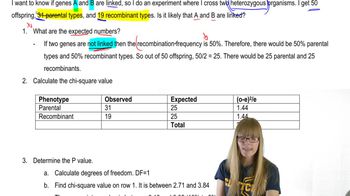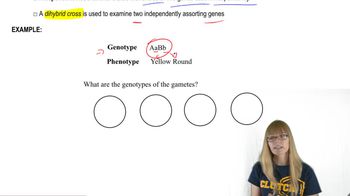Table of contents
- 1. Introduction to Genetics51m
- 2. Mendel's Laws of Inheritance3h 37m
- 3. Extensions to Mendelian Inheritance2h 41m
- 4. Genetic Mapping and Linkage2h 28m
- 5. Genetics of Bacteria and Viruses1h 21m
- 6. Chromosomal Variation1h 48m
- 7. DNA and Chromosome Structure56m
- 8. DNA Replication1h 10m
- 9. Mitosis and Meiosis1h 34m
- 10. Transcription1h 0m
- 11. Translation58m
- 12. Gene Regulation in Prokaryotes1h 19m
- 13. Gene Regulation in Eukaryotes44m
- 14. Genetic Control of Development44m
- 15. Genomes and Genomics1h 50m
- 16. Transposable Elements47m
- 17. Mutation, Repair, and Recombination1h 6m
- 18. Molecular Genetic Tools19m
- 19. Cancer Genetics29m
- 20. Quantitative Genetics1h 26m
- 21. Population Genetics50m
- 22. Evolutionary Genetics29m
2. Mendel's Laws of Inheritance
Sex-Linked Genes
Problem 6c
Textbook Question
In Drosophila, the map positions of genes are given in map units numbering from one end of a chromosome to the other. The X chromosome of Drosophila is 66 m.u. long. The X-linked gene for body color—with two alleles, y⁺ for gray body and y for yellow body—resides at one end of the chromosome at map position 0.0. A nearby locus for eye color, with alleles w⁺ for red eye and w for white eye, is located at map position 1.5. A third X-linked gene, controlling bristle form, with f⁺ for normal bristles and f for forked bristles, is located at map position 56.7. At each locus the wild-type allele is dominant over the mutant allele.
Do you expect any of these gene pair(s) to assort independently? Explain your reasoning.
 Verified step by step guidance
Verified step by step guidance1
<span>Step 1: Understand the concept of genetic linkage and independent assortment. Genes that are located close to each other on the same chromosome tend to be inherited together, a phenomenon known as genetic linkage. Independent assortment occurs when genes are located on different chromosomes or are far apart on the same chromosome.</span>
<span>Step 2: Identify the map positions of the genes on the X chromosome. The gene for body color is at 0.0 m.u., the gene for eye color is at 1.5 m.u., and the gene for bristle form is at 56.7 m.u.</span>
<span>Step 3: Calculate the distance between each pair of genes. The distance between the body color and eye color genes is 1.5 m.u. The distance between the eye color and bristle form genes is 55.2 m.u. The distance between the body color and bristle form genes is 56.7 m.u.</span>
<span>Step 4: Determine if the genes are likely to assort independently. Genes that are less than 50 m.u. apart are generally considered linked and do not assort independently. Genes that are 50 m.u. or more apart are likely to assort independently.</span>
<span>Step 5: Conclude which gene pairs, if any, are expected to assort independently based on their map distances. Consider the threshold of 50 m.u. for independent assortment.</span>
Recommended similar problem, with video answer:
 Verified Solution
Verified SolutionThis video solution was recommended by our tutors as helpful for the problem above
Video duration:
2mPlay a video:
Was this helpful?
Key Concepts
Here are the essential concepts you must grasp in order to answer the question correctly.
Gene Linkage
Gene linkage refers to the tendency of genes located close to each other on the same chromosome to be inherited together during meiosis. This occurs because linked genes are less likely to be separated by recombination events. In the context of Drosophila, the proximity of the body color gene (0.0 m.u.) and the eye color gene (1.5 m.u.) suggests they are linked, while the bristle form gene (56.7 m.u.) is farther away, indicating a potential for independent assortment.
Recommended video:
Guided course

Chi Square and Linkage
Independent Assortment
Independent assortment is a principle of genetics that states that alleles of different genes segregate independently of one another during gamete formation. This principle applies to genes located on different chromosomes or those that are far apart on the same chromosome. In the case of the Drosophila genes mentioned, the body color and eye color genes are close together, suggesting they may not assort independently, while the bristle form gene, being much farther away, may assort independently.
Recommended video:
Guided course

Gamete Genetics and Independent Assortment
Map Units (m.u.)
Map units (m.u.) are a unit of measurement used in genetics to describe the distance between genes on a chromosome, with one map unit equivalent to a 1% chance of recombination occurring between two genes. In the Drosophila example, the distances between the body color and eye color genes (1.5 m.u.) and the bristle form gene (56.7 m.u.) indicate their relative positions and likelihood of being inherited together. Smaller distances suggest a higher likelihood of linkage and lower chances of independent assortment.
Recommended video:
Guided course

Mapping Genes

 7:56m
7:56mWatch next
Master Sex-Linked Genes with a bite sized video explanation from Kylia Goodner
Start learningRelated Videos
Related Practice



